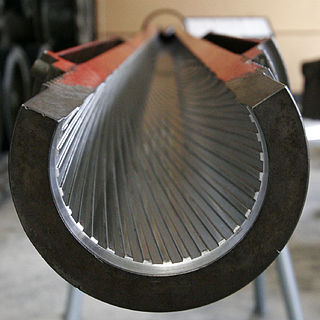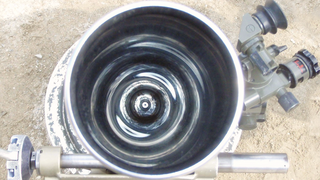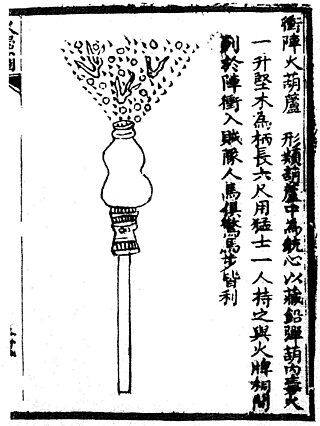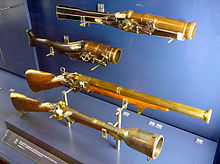
A firearm is any type of gun that uses an explosive charge and is designed to be readily carried and operated by an individual. The term is legally defined further in different countries.

Gunpowder, also commonly known as black powder to distinguish it from modern smokeless powder, is the earliest known chemical explosive. It consists of a mixture of sulfur, charcoal, and potassium nitrate (saltpeter). The sulfur and charcoal act as fuels while the saltpeter is an oxidizer. Gunpowder has been widely used as a propellant in firearms, artillery, rocketry, and pyrotechnics, including use as a blasting agent for explosives in quarrying, mining, building pipelines, tunnels, and roads.
A muzzleloader is any firearm in which the user loads the projectile and the propellant charge into the muzzle end of the gun. This is distinct from the modern designs of breech-loading firearms, in which user loads the ammunition into the breech end of the barrel. The term "muzzleloader" applies to both rifled and smoothbore type muzzleloaders, and may also refer to the marksman who specializes in the shooting of such firearms. The firing methods, paraphernalia and mechanism further divide both categories as do caliber.

Rifling is the term for helical grooves machined into the internal surface of a firearms's barrel for imparting a spin to a projectile to improve its aerodynamic stability and accuracy. It is also the term for creating such grooves.

A grenade launcher is a weapon that fires a specially designed, large-caliber projectile, often with an explosive, smoke, or gas warhead. Today, the term generally refers to a class of dedicated firearms firing unitary grenade cartridges. The most common type are man-portable, shoulder-fired weapons issued to individuals, although larger crew-served launchers are issued at higher levels of organization by military forces.

A mortar today is usually a simple, lightweight, man-portable, muzzle-loaded cannon, consisting of a smooth-bore metal tube fixed to a base plate with a lightweight bipod mount and a sight. Mortars are typically used as indirect fire weapons for close fire support with a variety of ammunition. Historically mortars were heavy siege artillery. Mortars launch explosive shells in high-arching ballistic trajectories.

A shell, in a military context, is a projectile whose payload contains an explosive, incendiary, or other chemical filling. Originally it was called a bombshell, but "shell" has come to be unambiguous in a military context. A shell can hold a tracer.

A smoothbore weapon is one that has a barrel without rifling. Smoothbores range from handheld firearms to powerful tank guns and large artillery mortars.
In the United States, a destructive device is a type of firearm or explosive device regulated by the National Firearms Act of 1934, revised by the Omnibus Crime Control and Safe Streets Act of 1968 and Gun Control Act of 1968.

Early thermal weapons, which used heat or burning action to destroy or damage enemy personnel, fortifications or territories, were employed in warfare during the classical and medieval periods.

A ranged weapon is any weapon that can engage targets beyond hand-to-hand distance, i.e. at distances greater than the physical reach of the user holding the weapon itself. The act of using such a weapon is also known as shooting. It is sometimes also called projectile weapon or missile weapon because it typically works by launching solid projectiles ("missiles"), though technically a fluid-projector and a directed-energy weapon are also ranged weapons. In contrast, a weapon intended to be used in hand-to-hand combat is called a melee weapon.

The hand cannon, also known as the gonne or handgonne, is the first true firearm and the successor of the fire lance. It is the oldest type of small arms, as well as the most mechanically simple form of metal barrel firearms. Unlike matchlock firearms it requires direct manual external ignition through a touch hole without any form of firing mechanism. It may also be considered a forerunner of the handgun. The hand cannon was widely used in China from the 13th century onward and later throughout Eurasia in the 14th century. In 15th century Europe, the hand cannon evolved to become the matchlock arquebus, which became the first firearm to have a trigger.

Rocket artillery is artillery that uses rockets as the projectile. The use of rocket artillery dates back to medieval China where devices such as fire arrows were used. Fire arrows were also used in multiple launch systems and transported via carts. The first true rocket artillery was developed in South Asia by Tipu Sultan, the ruler of the Kingdom of Mysore. In the late nineteenth century, due to improvements in the power and range of conventional artillery, the use of early military rockets declined; they were finally used on a small scale by both sides during the American Civil War. Modern rocket artillery was first employed during World War II, in the form of the German Nebelwerfer family of rocket ordnance designs, Soviet Katyusha-series and numerous other systems employed on a smaller scale by the Western allies and Japan. In modern use, the rockets are often guided by an internal guiding system or GPS in order to maintain accuracy.

A fougasse is an improvised mortar constructed by making a hollow in the ground or rock and filling it with explosives and projectiles. The fougasse was used by Samuel Zimmermann at Augsburg in the sixteenth century, referred to by Vauban in the seventeenth century, and well known to military engineers by the mid-eighteenth century. This technique was used in several European wars, the American Revolution, and the American Civil War. The term is still used to describe such devices.

The history of the firearm begins in 10th-century China, when tubes containing gunpowder projectiles were mounted on spears to make portable fire lances. Over the following centuries, the design evolved into various types, including portable firearms such as flintlocks and blunderbusses, and fixed cannons, and by the 15th century the technology had spread through all of Eurasia. Firearms were instrumental in the fall of the Byzantine Empire and the establishment of European colonization in the Americas, Africa, and Oceania. The 19th and 20th centuries saw an acceleration in this evolution, with the introduction of the magazine, belt-fed weapons, metal cartridges, rifled barrels, and automatic firearms, including machine guns.

Title II weapons, or NFA firearms, are designations of certain weapons under the United States National Firearms Act (NFA).

A grenade is an explosive weapon typically thrown by hand, but can also refer to a shell shot from the muzzle of a rifle or a grenade launcher. A modern hand grenade generally consists of an explosive charge ("filler"), a detonator mechanism, an internal striker to trigger the detonator, an arming safety secured by a transport safety. The user removes the transport safety before throwing, and once the grenade leaves the hand the arming safety gets released, allowing the striker to trigger a primer that ignites a fuze, which burns down to the detonator and explodes the main charge.

A gun is a device designed to propel a projectile using pressure or explosive force. The projectiles are typically solid, but can also be pressurized liquid, or gas. Solid projectiles may be free-flying or tethered. A large-caliber gun is also called a cannon.

The Chongtong was a term for military firearms of Goryeo and Joseon dynasty. The size of chongtong varies from small firearm to large cannon, and underwent upgrades, which can be separated in three generation type. The well-known "Cheonja", "Jija", "Hyeonja", and "Hwangja" were named after the first four characters of the Thousand Character Classic in decreasing size, thus making them equivalent to Cannons A, B, C, and D.

The Heilongjiang hand cannon or hand-gun is a bronze hand cannon manufactured no later than 1288 and is the world's oldest confirmed surviving firearm. It weighs 3.55 kg and is 34 centimeters long. The Heilongjiang hand cannon was excavated during the 1970s in Banlachengzi, a village in Acheng District, Heilongjiang province, China. It was found alongside other bronze artifacts made in the style of the Jurchen Jin Dynasty. The hand cannon was probably used in battles fought nearby in Banlachengzi in 1287 and 1288. The History of Yuan states that a Jurchen commander by the name of Li Ting led a group of soldiers equipped with hand cannons into a military camp in 1288, as part of an anti-rebellion campaign for the Yuan dynasty. The cannon currently resides at the Heilongjiang Provincial Museum in Harbin, China.




















